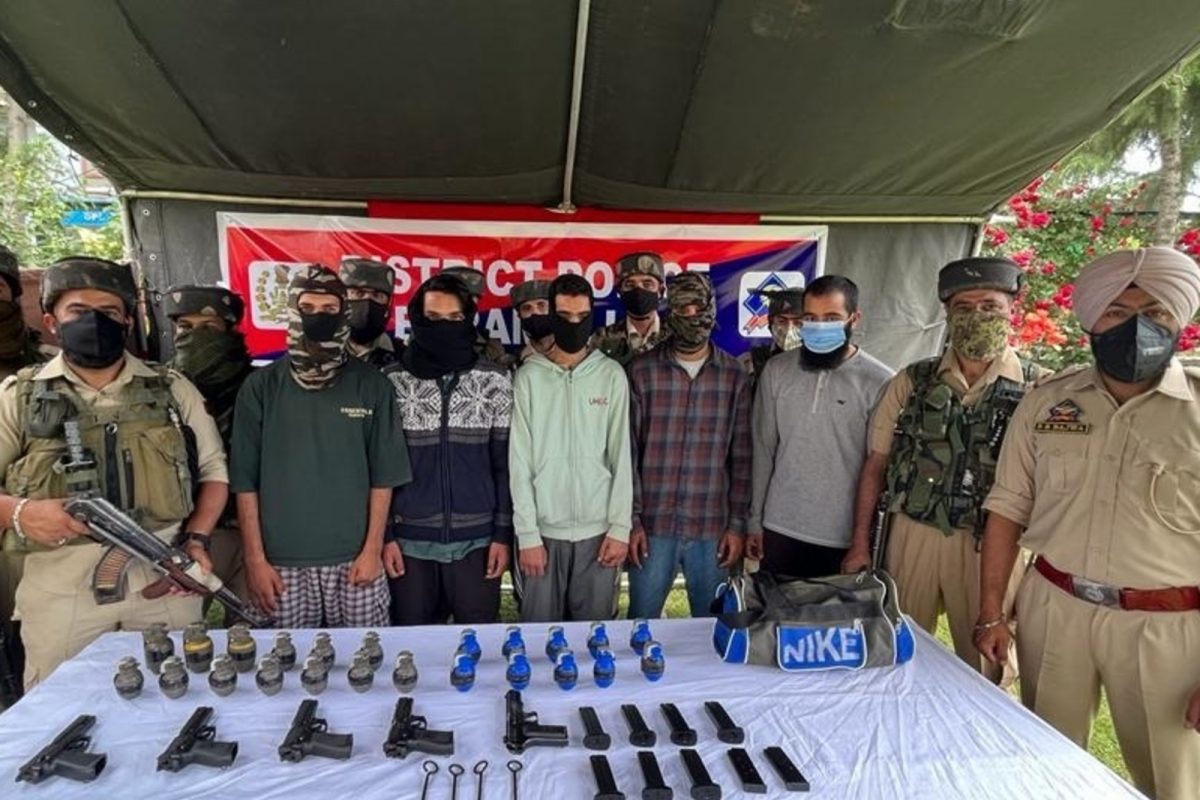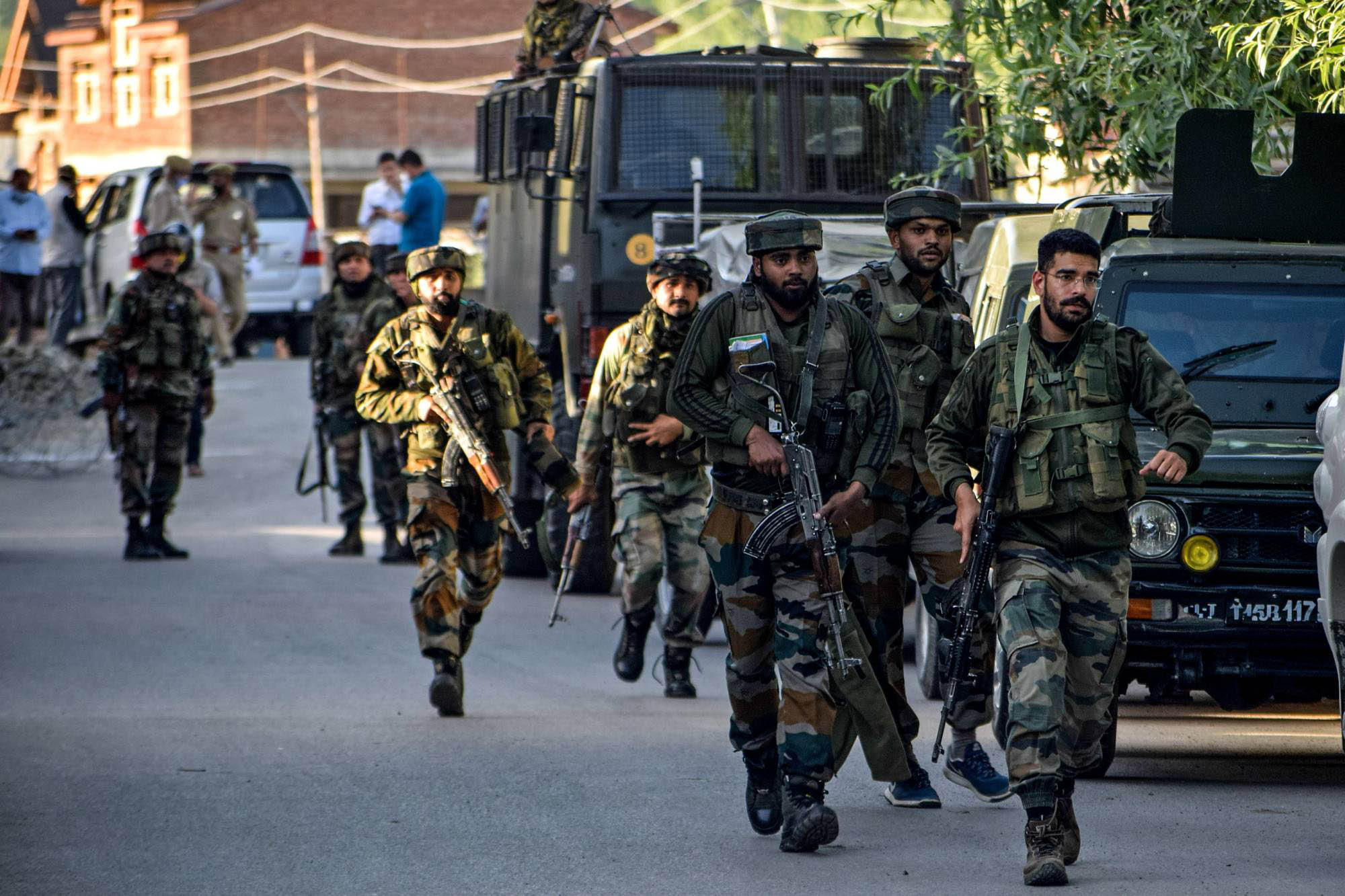
While there has been a spurt in the militant violence in Kashmir, there is a fresh evidence that proves that more foreign militants, armed with an array of weapons left behind by the US in Afghanistan, are infiltrating into the valley, reports Riyaz Wani
The recent past has witnessed a sudden spurt in the militancy-related incidents in Kashmir, with militants escalating their attacks on minorities and outsiders. What is more, there is now evidence of more foreign militants infiltrating into Kashmir and that too with an array of arms left behind in Afghanistan by the US.
Several attacks in recent weeks have made the situation very challenging for the security forces. On May 17, a burqa-clad militant hurled a grenade at a wine shop in a high-security zone in North Kashmir town of Baramulla, killing one person and injuring three others.
Earlier on May 13, a bus full of pilgrims headed from Katra to Jammu caught fire near Kharmal killing four people and injuring 22 others. Later, preliminary investigations revealed that a sticky bomb was used to blow up the bus.
A little-known militant outfit Jammu & Kashmir Freedom Fighters (JKFF) claimed responsibility for the bus blast. In a 46-second video, JKFF Commander Nadeem Chaudhary has not only claimed a hand of the outfit in the attack but has also warned of more such attacks in near future.

Attacks like these went alongside the targeted killings of the policemen and the minorities. One such killing was of the revenue employee Rahul Bhat which triggered protests by Kashmiri Pandits. In Bhat’s case, militants went inside the tehsil office in the central Kashmir town of Budgam and killed him.
Bhat was one of the several thousand Kashmiri Pandit employees working in various government departments of Kashmir. The attack has endangered the lives of all of them, forcing the government to shift them from the vulnerable areas to “safer places”. But it seems unlikely to be of much help considering the security situation in the Valley is worsening by the day. This has only further raised the security responsibilities of the UT government which is already bogged down in fighting the militancy.
More militancy, less militants
The surge in violence has come despite the fact that the number of militants has dwindled under 200 over the last year, the first time this has happened since 2015 when the slain militant commander Burhan Wani reinvigorated the then flagging militancy.
“It is an open thing that militant numbers have come down. For the first time, militant numbers have reduced below 200 and we will bring it further down,” the Inspector General of Police Kashmir Vijay Kumar said recently. “Some people had guessed that numbers will rise but there is nothing of this sort.”
Ever since the withdrawal of J&K autonomy in August 2019, around 500 militants have been killed in the UT, most of them local youth. Though this has reduced the number of militants, the violence has continued unchanged. And over the last year, the violence has increased as militants have chosen to attack soft targets – civilians, panchayat workers, J&K police personnel visiting home, outsiders and minorities – instead of engaging security personnel. Security forces, as a result, now not only have to combat militancy but also protect a large section of population including many from among their own ranks.
Overall normalcy holds
The resurgence in the violence hasn’t, however, dented the larger drift of normalcy in the Valley yet. While the violence has become more conspicuous in recent months, it is still on the margins in so far as its impact on the daily life is concerned. Tourism is at an all time high after many years. Between January and May 15 of 2022, the tourist arrivals in the Valley have jumped to 700,000 – over four times the 125,0000 seen in the the same period during pandemic-hit last year – according to the data from the Jammu and Kashmir Tourism Department and the Union Tourism Ministry. Most hotels, according to UT’s tourism department, are booked through the summer.
The biggest draws for the tourists are the resorts like Gulmarg, Pahalgam and Dal lake. Tourism sector forms 6.8 percent of Kashmir’s GDP and employs 2 million people. The sector has also been helped by the ban on international travel that was in force for the better part of the last two years.
Everyday rush of tourists and their movement in Srinagar and presence in the city’s restaurants has made things look quite normal.
What has made this possible? A combination of factors: One, there is this perception across the country that after revocation of Article 370, J&K has been fully integrated into India; second, Covid-19 fallout which severely reduced the options to go abroad; and third the ongoing sweltering summer in the mainland India which has forced people to escape to colder places like Kashmir. And if the veteran Congress leader Ghulam Nabi Azad is to be believed, the tourism boom in the Valley is certainly not the test of “better situation.”
““I give full credit for the tourism boom to the Almighty as the rising temperatures in Delhi and the rest of the country prompted people to look for cooler environs in Kashmir, Shimla and elsewhere,” Azad said during his recent trip to Jammu.
Upcoming Yatra
With annual Amarnath Yatra scheduled to kick off by the end of June, the government is not leaving anything to chance in view of the deteriorating security situation.
On May 21, the Lieutnant Governor Manoj Sinha reviewed the Yatra arrangements. He said his administration’s priority is to ensure best facilities for the pilgrims participating in the pilgrimage.
Earlier, Inspector General of Police Vijay Kumar also reviewed security arrangements for the Yatra and among other dangers, the meeting also discussed the threat of sticky bombs and drones. The IGP stressed on generating specific intelligence and conducting anti-militant operations along the Yatra route.
Making the situation more challenging is that earlier in May, security forces killed Hizbul Mujahideen’s oldest commander Mohammad Ashraf Khan, 57, and two more militants in a shootout inside the forests of Srichand Top in Pahalgam, close to the Amarnath Yatra route in south Kashmir’s Anantnag district.
The government has now decided to track all pilgrims using Radio Frequency Identification (RFID) tags. The RFID is a wireless tracking system that consists of tags and readers. The decision to track all Amarnath pilgrims using RFID tags was taken following a security review meeting chaired by the Union Home Minister Amit Shah.
“The Chief Secretary of Jammu and Kashmir said that for the first time every Amarnath Yatri would be given a RIFD card and would be insured for Rs. 5 lakh. A tent city, WiFi hotspots and proper lighting will be arranged on the Yatra’s travel route,” a statement by the MHA said.
The Centre has reportedly decided to deploy additional 15,000 paramilitary troops in the Kashmir Valley, in addition to a large number of forces already on Yatra duty.
Weapons from Afghanistan
The coming weeks and months of summer will be thus crucial in terms of the evolving security situation in the Valley. Summer is usually the time when the infiltration takes place and a little more escalation in the influx of the fully equipped militants could change the ground situation in Kashmir for the worse.
Already, according to security officials, some weaponry from Afghanistan has found its way into Kashmir. Videos showing militants carrying M249 automatic rifles, 509 tactical guns, M1911 pistols, and M4 carbine rifles have surfaced in recent weeks. Security forces have also found over a dozen Iridium satellite phones and Wifi-enabled thermal imagery devices that help militants to infiltrate safely and circumvent security cordons during the night.
Speaking at the recent Raisina Dialogue, former Army chief General MM Naravane had also confirmed that the Afghan war weapons had made their way into Kashmir “There is definitely an increase in the number of weapons and other equipment, especially night-vision devices that we are capturing or unearthing, which definitely have come from Afghanistan,” General Naravane had said.













